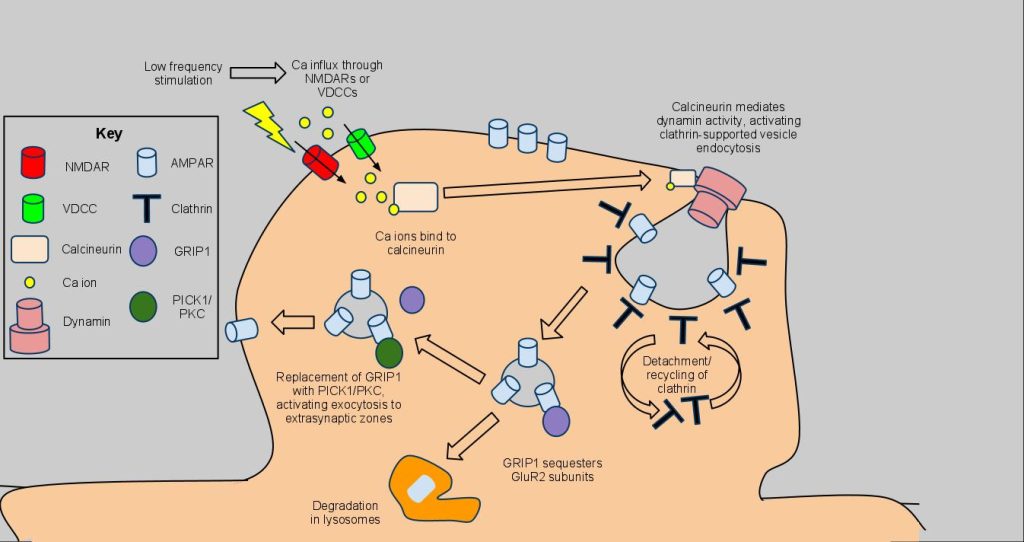If we keep talking about “emotional hijacks,” then we will likely keep playing whack-a-mole with our triggers. Typical workplace EI advice for triggers comes as “forewarned is forearmed,” but really the encodings that the brain installed — the ones that fire off when we are triggered — were installed for protective reasons. After all, these biological spacesuits we all have are survival suits first. When we are triggered, something about the current situation/ environment/ internal landscape is likely similar to a past threatening experience where information about a threat or trauma was encoded — for future safety.
When I say encoded, I mean that APMA receptors were literally installed in the brain to let traffic flow if something similar should happen again (encoding not just the threatening content, but whatever else was surrounding it – sights, sounds, smells, etc).
As the philosopher, Langer, wrote in her book, Mind: An Essay on Human Feeling: “To feel is to do something.” And everything about the biological spacesuit’s functionings and tweaking of functionings has a helpful/”helpful” intent behind it. (I use “helpful” to note that though the biological spacesuit — we’re talking body, mind, parts within — is always doing its best to be helpful, sometimes the outcomes are not so helpful. Hence, I say “helpful.”)
Okay I’m Hijacked.. Er, I mean Having a Feathers Up Response… Now What?

The first thing I would do if triggered, would be to assess: Is this a situation in which any human would be sent into fight or flight mode?
For example, the Tom & Jerry piano crash shown below, we know that any human (or Earthling) would experience a behind-the-scenes mobilization response:
Just watch the infamous piano crash (2 seconds) and move on. 😉
If it’s really a situation that would elicit a mobilization response (sympathetic nervous system) in any human, cat, or mouse, then it’s likely merely a matter of getting to safety and letting your body know you are safe. If you have ways that you love to get your biological space suit to GREEN (aka GREEN Feather Mode, aka ventral vagal activation), then use those tools (lots of ideas here).

(The feather-O-meter is based on neuroscience, specifically Polyvagal Theory and Positive Psychology.)
Piano Comes Flying at You: Insta Feathers Up Response (Biological Spacesuit Thrown into YELLOW Feather Mode)

If you look at the 💭💭 bubbles 💭💭 in the image above, you can see (left side) that there is diminished blood flow to the prefrontal cortex. For more information on this, check out this article, and especially the mid-page graphic (I promise, it’s worth it — truly worth 1000 words). The gist of the article is:
- The brain’s prefrontal cortex, responsible for higher cognitive abilities like concentration and decision-making, is highly sensitive to stress.
- Acute, uncontrollable stress weakens the influence of the prefrontal cortex and enhances older brain structures involved in primal reactions and emotions.
- Stress floods the brain with arousal chemicals, leading to the shutdown of prefrontal cortex neurons and a loss of self-control.
- Some people may be more vulnerable to stress due to genetic factors or previous stress exposure.
- Chronic stress can lead to long-term changes in brain connections and contribute to conditions like depression, addiction, and anxiety disorders.
On the right side of the image above, the 💭 shows the story we have about the world when our biological spacesuit is thrown into (or chronically stuck in) YELLOW feather mode. The world is a dangerous place. Hence the action tendency for the FEAR emotion kicks in: fight or run. Negativity (which is not bad) comes with rigid action tendencies. FEAR ==> run or fight. DISGUST ==> hurl. Mammalian brains have at least seven primary-process emotional action systems, which serve as survival guides. The negative emotions have more rigid responses because the goal is survival. The “positive” emotions are more about thriving, and we have more a expansive (and perhaps unending list) of action responses. Hence Dr Steve Rudin called these forms of positivity e-notions. But let’s get back to the e-motions:


Sizing Up Social Threats
Pianos are easy, but how do we better answer: Is this a situation in which any human would be sent into fight or flight mode?
In The SQ Workshop, we check SPACE:

Most people will get thrown into YELLOW feather-mode if there is a threat to belonging, things that give them meaning, their autonomy (self-direction), certainty (our brains hate, hate, HATE uncertainty), and fairness. The SCARF Model is also fantastic:
Noticing Your Biological Spacesuit’s Custom Tweaks: Trauma/Threat Based Encodings
Watch these two videos to see how trauma gets encoded in the brain (built into your neurons) and how it is dismantled.
Video Recaps:

- Traumatic events cause fast gamma waves in the brain, encoding memories in the amygdala.
- The amygdala’s protection mechanism involves AMPA receptors getting super glued to the cell membrane, retaining sensory data related to the trauma. These receptors are also ion channels, meaning they will let information flow this way in the future — for your survival!
- Havening Touch is a healing technique based on neuroscience that uses touch and eye movements to create delta waves in the brain. The slower waves and slower ion oscillations within the neuron with the trauma encoding affects the opposite mechanism: activated AMPA receptors are prone to being “un-super glued.” The result is the removal of the emotional charge. We can still tell the story of what happened, but the felt sense response is gone.
- Traumatic encoding in the brain requires four factors: event, meaning, landscape, and inescapability (EMLI).
- The event must be experienced through the senses and can be external or internal.
- Meaning is assigned to the event, and it is perceived as threatening or potentially threatening.
- A permissive vulnerable landscape in the brain at the time of the event is necessary for traumatic encoding.
- The event must be perceived as inescapable, creating a sense of powerlessness.
- When we activate the trauma encoding and then generate delta waves, we are showing the biological spacesuit that WE DID ESCAPE. The AMPA receptors are endocytosed. You can look at the technical diagram, or think of Hungry Hungry Hippos:

Used with permission — CC license, created by Psy165s2011

Okay, So I Believe It’s a “Helpful” Encoding… Now What?

Well, even if I don’t mention it in every post, the disclaimer on our site is: We work with derailers not disorders. This post is being shared in the spirit of Embodied EQ. We are not therapists. If you need (or think you need) medical attention, then go do that. Otherwise, you can Haven yourself. (More to come on this.)
Note that your biological spacesuit has made helpful/”helpful” tweaks along the way, based on your circumstances, experiences, how you used your suit, etc. We recommend that you have compassion and curiosity for yourself. Here’s some AI art we made which shows helpful/”helpful” tweaks that could be made to a biological spacesuit:

Havening Techniques®
Please watch the 2 Havening Videos above before proceeding. They will set a good foundation as to what Havening Touch® is and why it works.
Self Havening to Clear an Unhelpful Event
CPR for the Amygdala (On the Spot Stress Relief)
